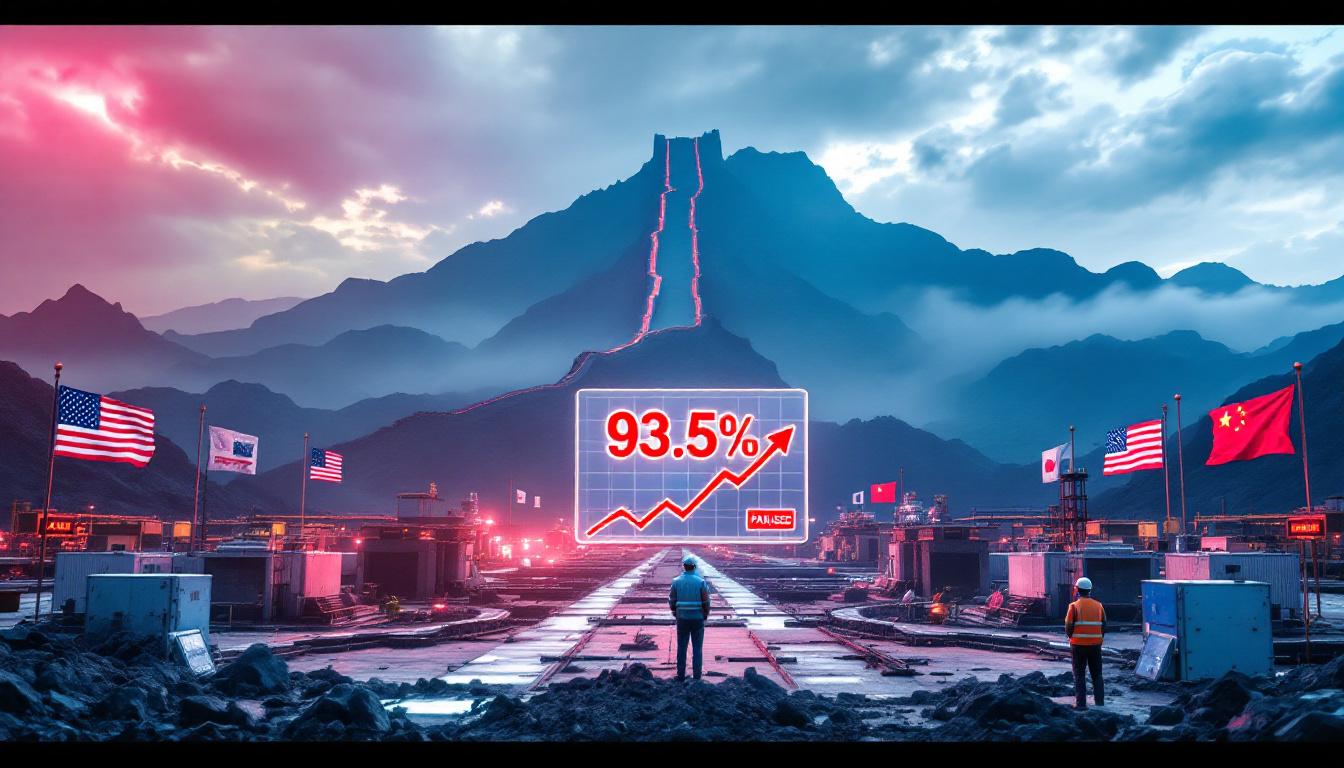Understanding Rio Tinto's Lithium Strategy: Market Implications and Future Outlook
Rio Tinto has embarked on an aggressive expansion into the lithium sector, highlighted by its recent US$6.7 billion acquisition of Arcadium Lithium. This strategic move follows the company's earlier US$825 million investment in Argentina's lithium project, demonstrating a clear commitment to building a substantial lithium portfolio. The mining giant is positioning itself as a major player in the battery metals market, diversifying beyond its traditional iron ore focus.
According to Panmure Liberum analysts, "Rio's lithium strategy presents growth opportunities but faces geopolitical and execution risks" – a balanced assessment that captures both the potential and challenges ahead for the mining giant.
While iron ore contributed approximately 60% of Rio Tinto's 2024 revenue, the company clearly sees lithium as a critical component of its future growth strategy. This pivot represents one of the most significant portfolio shifts in the company's recent history.
How Arcadium Strengthens Rio Tinto's Lithium Position
Production Capacity and Growth Trajectory
The Arcadium acquisition immediately bolsters Rio Tinto's lithium capabilities, providing established operations rather than starting from scratch. The company is targeting production of 225,000 tonnes of lithium carbonate equivalent (LCE) annually by 2028, with ambitious plans to reach 460,000 tonnes LCE by 2033.
This production timeline significantly accelerates Rio Tinto's entry into the lithium market compared to the traditional greenfield development approach, which often requires 7-10 years from discovery to production.
Arcadium's diverse asset portfolio includes brine operations in the Argentina lithium market and hard-rock mines in Australia, providing geographic diversification that helps mitigate regional risks. The Fenix brine operation in Argentina, previously under Livent's management, already produces approximately 20,000 tonnes LCE annually—providing immediate production capacity and cash flow.
Strategic Advantages
Beyond just adding production volume, the acquisition brings several strategic benefits:
- Technical expertise acquisition: Rio gains access to Arcadium's established technical teams with specialized knowledge in lithium extraction and processing
- Geographic diversification: Assets spanning Argentina, Australia, and Canada reduce exposure to country-specific risks
- Processing capabilities: Immediate access to operational refining facilities rather than building from scratch
- Time-to-market reduction: Years saved compared to developing greenfield projects independently
This multi-continental footprint provides flexibility in production decisions and creates potential synergies with Rio Tinto's existing operations, particularly in Australia where the company has deep operational experience.
Why Rio Tinto is Pivoting Toward Lithium
Reducing Iron Ore Dependency
Rio Tinto's strategic shift toward lithium comes amid growing concerns about plateauing Chinese steel production, which directly impacts the company's core iron ore business. World Steel Association data indicates that China's steel output growth has slowed significantly, with some forecasts suggesting peak production may have already occurred.
"Lithium is central to the energy transition," noted Rio Tinto CEO Jakob Stausholm in a Q1 2025 investor presentation, signaling the company's commitment to pivoting toward future-facing commodities.
This diversification strategy serves multiple purposes:
- Reducing vulnerability to iron ore price fluctuations
- Creating new growth vectors as traditional mining segments mature
- Aligning the company portfolio with global decarbonization trends
- Positioning for premium valuations associated with battery material producers
Market Opportunity Assessment
The market opportunity in lithium appears substantial. Electric vehicle battery demand is projected to grow at a 20% CAGR through 2030, according to BloombergNEF's 2024 forecast. This growth isn't limited to consumer vehicles—commercial fleets, energy storage systems, and industrial applications are all driving increased battery production.
Key market drivers include:
- Global policy support for electric vehicle adoption
- Corporate fleet electrification commitments
- Utility-scale energy storage deployments
- Consumer preference shifts toward electric vehicles
- Battery manufacturing capacity expansions
These factors combine to create what Rio Tinto clearly sees as a generational opportunity to establish a leading position in a critical material for the energy transition.
Challenges Facing Rio Tinto's Lithium Strategy
Market Dynamics Concerns
Despite the promising outlook, Rio Tinto faces significant challenges in executing its lithium strategy. China's dominance in the lithium supply chain represents a particular concern, with Chinese companies controlling approximately 60% of global lithium refining capacity according to USGS data from 2024.
This market concentration creates potential vulnerabilities:
- Price influence by dominant Chinese processors
- Access challenges to key refining technologies
- Competition with established Chinese battery material suppliers
- Geopolitical tensions affecting trade flows
Price volatility presents another major challenge. Lithium carbonate spot prices experienced a dramatic 70% drop in 2023 following a period of record highs, demonstrating the commodity's susceptibility to rapid market shifts. Such volatility complicates investment planning and return forecasting.
"The lithium market remains highly cyclical despite long-term growth prospects. Companies entering now must be prepared for significant price fluctuations during the ramp-up phase." – Mining industry analyst, 2024
Execution Risks
Rio Tinto also faces substantial execution risks in implementing its lithium strategy:
- Integration challenges: Merging Arcadium's operations and culture with Rio Tinto's systems
- Leadership transition: CEO Jakob Stausholm's upcoming departure creates uncertainty around strategic continuity
- Capital allocation tensions: Balancing investment between traditional cash-generating assets and growth-oriented lithium projects
- Technical expertise gaps: Building specialized knowledge in lithium processing technologies
Panmure Liberum analysts highlighted that the "CEO transition [Jakob Stausholm's departure] creates execution uncertainty" for Rio Tinto's lithium strategy, raising questions about how the incoming leadership will prioritize and manage this new direction.
Analyst Views on Rio Tinto's Lithium Expansion
Cautious Outlook from Market Observers
Financial analysts have adopted a generally cautious stance on Rio Tinto's lithium expansion. Panmure Liberum maintains a 'hold' recommendation with a price target of 4,500p compared to the current trading price of 4,451p, suggesting limited near-term upside despite the strategic shift.
Their assessment balances:
- Long-term growth potential in the lithium market
- Near-term integration and execution challenges
- Significant capital requirements for project development
- Uncertainty around lithium price stability
The consensus among analysts appears to be that while the strategic direction makes sense, the execution timeline and financial returns remain uncertain.
Financial Projections
Financial projections reflect this cautious outlook. Earnings per share are forecast to decline from US$6.67 in 2024 to US$2.57 by 2026, according to Panmure Liberum's May 2025 analysis. This projected earnings compression highlights the near-term costs of Rio Tinto's strategic pivot.
Several factors contribute to this earnings forecast:
- Substantial capital expenditure requirements for lithium project development
- Integration costs associated with the Arcadium acquisition
- Potential dilution of returns from higher-margin iron ore business
- Assumed conservative lithium price forecasts given recent volatility
Panmure Liberum notes that "long-term potential [is] offset by near-term earnings volatility," capturing the tension between strategic positioning and short-term financial performance.
Geopolitical Considerations Affecting Rio Tinto's Lithium Strategy
Supply Chain Security Concerns
The lithium industry operates against a backdrop of growing government focus on critical mineral supply chains. Western nations have become increasingly concerned about China's dominance in battery materials processing and are actively seeking to develop alternative supply chains.
This geopolitical landscape creates both opportunities and challenges for Rio Tinto:
- Opportunities: Potential premium pricing for "friendly nation" lithium supplies; government support for non-Chinese supply chains
- Challenges: Navigating competing national interests; potential for restrictive regulations
The U.S. Inflation Reduction Act of 2022 exemplifies this trend, providing substantial incentives for domestically sourced battery materials and creating potential advantages for Western suppliers like Rio Tinto.
Regional Dynamics
Argentina has emerged as a key focus area for Rio Tinto's lithium strategy. The country's lithium exports rose 90% year-over-year in 2024, according to Argentina's Ministry of Mining, highlighting its growing importance in global lithium supply.
However, the region presents regulatory complexities:
- Proposed lithium export taxes in Argentina's 2025 draft legislation
- Local community considerations around water usage and environmental impacts
- Political instability affecting long-term investment planning
- Competition with other international miners for prime assets
Australia offers a more stable jurisdiction with established mining regulations, though with higher operating costs. North America presents opportunities aligned with domestic battery manufacturing growth, particularly given the IRA incentives and the development of a major US lithium project.
How Rio Tinto's Strategy Compares to Competitors
Competitive Landscape Analysis
Rio Tinto's lithium strategy must be viewed in the context of intensifying competition across the sector. Albemarle, the world's largest lithium producer, reported 2023 production of approximately 200,000 tonnes LCE according to its annual report, setting a benchmark that Rio Tinto aims to surpass by 2028.
The competitive landscape includes several distinct player categories:
- Major diversified miners: BHP, Glencore, and others evaluating lithium opportunities
- Established lithium specialists: Albemarle, SQM, Ganfeng with substantial existing production
- Battery manufacturers: CATL, LG Energy Solution securing upstream supplies
- Automotive OEMs: Tesla, Volkswagen investing directly in lithium resources
Each competitor brings different advantages. Specialized lithium producers like SQM have deeper technical expertise but less financial capacity than Rio Tinto. Automotive manufacturers bring guaranteed offtake potential but less mining experience.
Differentiation Factors
Rio Tinto's competitive positioning relies on several key differentiators:
- Financial capacity: Ability to fund large-scale projects and acquisitions
- Project development expertise: Track record in building complex mining operations
- ESG credentials: Commitment to responsible mining practices
- Global marketing reach: Established relationships with industrial customers worldwide
This creates a somewhat different approach than BHP's recent strategic pivot toward potash through its Jansen project, highlighting divergent views on which commodities will drive future growth among the mining majors.
When benchmarking Rio Tinto's 2033 production target of 460,000 tonnes against competitors, it significantly exceeds SQM's 2030 goal of 300,000 tonnes, positioning Rio to potentially become one of the world's largest lithium producers if execution proceeds as planned.
Technological Factors Impacting Rio Tinto's Lithium Investments
Battery Chemistry Evolution
The lithium investment thesis faces potential disruption from evolving battery technologies. Research into alternative chemistries continues to advance, with sodium-ion batteries projected to capture approximately 10% of the EV market by 2035, according to IDTechEx's 2024 forecast.
While lithium-ion remains the dominant chemistry, several technological developments merit monitoring:
- Solid-state battery research advancing toward commercialization
- Lithium-sulfur batteries offering higher energy density potential
- Lithium-iron-phosphate (LFP) gaining market share in cost-sensitive applications
- Sodium-ion emerging as a potential alternative for some applications
Each of these developments could affect lithium demand forecasts and pricing dynamics, though most analysts expect lithium to remain the dominant battery metal for at least the next decade.
Processing Innovations
Innovations in lithium extraction and processing technologies could significantly impact the economics and environmental footprint of Rio Tinto's operations. Direct lithium extraction technologies represent a particularly important development, reducing water usage by approximately 50% compared to traditional evaporation ponds, according to OECD research from 2023.
Rio Tinto has been exploring partnerships with DLE technology providers like Lilac Solutions to enhance efficiency and sustainability in its lithium operations. These technological advancements could:
- Reduce operational costs through improved recovery rates
- Minimize environmental impacts, particularly water usage
- Accelerate production timelines compared to traditional methods
- Improve lithium product purity and consistency
The mining giant's ability to successfully implement these advanced technologies will be crucial to achieving both its production targets and sustainability commitments.
Long-term Outlook for Rio Tinto's Lithium Strategy
Growth Potential Assessment
The long-term outlook for Rio Tinto's lithium strategy depends on multiple intersecting trends. Global lithium demand could reach 3.7 million tonnes by 2035 according to CRU Group's 2024 forecast, driven by:
- Continued electric vehicle adoption across price segments
- Growth in utility-scale battery storage deployments
- Industrial decarbonization initiatives increasing battery requirements
- Consumer electronics maintaining baseline demand
Rio Tinto's targeted production capacity would represent approximately 12% of this projected global demand, suggesting substantial room for growth if market forecasts materialize.
ESG considerations will likely play an increasing role in determining market premiums. Rio Tinto has stated its aim of "targeting top-quartile sustainability performance in lithium" according to its 2025 Climate Report, positioning the company to potentially capture premium pricing from ESG-focused customers.
Strategic Positioning
Beyond just production volumes, Rio Tinto's strategic positioning in the lithium market will depend on several factors:
- Vertical integration potential: Opportunities to move downstream into higher-value products
- Customer relationships: Securing long-term offtake agreements with battery manufacturers
- Technological differentiation: Developing proprietary processing capabilities
- Portfolio optimization: Balancing lithium with traditional mining segments
Morningstar Sustainalytics ratings and similar ESG metrics will increasingly influence investor perceptions, potentially affecting Rio Tinto's valuation multiple as its lithium business develops.
The success of this strategic pivot will ultimately be judged not just on production volumes but on the company's ability to generate sustainable returns throughout market cycles and position itself as an essential supplier to the energy transition, particularly through developing a battery-grade lithium refinery capability and adopting Australia lithium innovations.
FAQ: Rio Tinto's Lithium Strategy
How significant is the Arcadium acquisition for Rio Tinto?
The US$6.7 billion Arcadium acquisition represents one of Rio Tinto's largest strategic moves into the battery materials sector. It provides immediate production capacity through operational assets in Argentina and Australia, along with a clear growth pathway to potentially becoming one of the world's largest lithium producers by 2033.
The acquisition fundamentally transforms Rio Tinto's position in the lithium market, moving it from a potential future player to an immediate significant producer with established technical expertise and customer relationships.
Will Rio Tinto's lithium investments significantly impact its overall financial performance?
Analysts remain cautious about the near-term financial impact of Rio Tinto's lithium strategy. Panmure Liberum's projections show earnings per share declining from US$6.67 in 2024 to US$2.57 by 2026, reflecting substantial capital requirements and integration costs.
The full benefits of the lithium strategy may take several years to materialize as production scales up and market positions are established. Long-term financial impact will depend heavily on lithium price trends, operational execution, and the company's ability to optimize its broader portfolio during the transition.
How does Rio Tinto's lithium strategy align with global decarbonization efforts?
By expanding its lithium portfolio, Rio Tinto is positioning itself as a key supplier to the battery industry, which supports electric vehicle adoption and renewable energy storage—both critical components of global decarbonization initiatives.
The company has emphasized sustainability in its lithium operations, targeting "top-quartile sustainability performance" according to its 2025 Climate Report. This focus on responsible production aligns with increasing customer and investor emphasis on ESG performance throughout the battery supply chain.
What risks could undermine Rio Tinto's lithium investments?
Several significant risks could impact Rio Tinto's lithium strategy:
- Price volatility: Lithium's 70% price decline in 2023 demonstrates the market's susceptibility to rapid shifts
- Technological disruption: Alternative battery chemistries like sodium-ion could reduce lithium demand growth
- Chinese dominance: China's control of approximately 60% of global lithium processing creates competitive challenges
- Regulatory complexity: Operating across multiple jurisdictions exposes the company to varying regulatory risks
The company's ability to navigate these risks while executing its production growth plans will determine the ultimate success of its lithium strategy.
How does the upcoming CEO transition affect Rio Tinto's lithium strategy?
The departure of CEO Jakob Stausholm, who has been a strong advocate for Rio Tinto's lithium expansion, creates uncertainty about the continuity and execution of the company's battery materials strategy.
Panmure Liberum analysts specifically highlighted the CEO transition as creating "execution uncertainty" for the lithium strategy. The incoming leadership's commitment to the current strategic direction, capital allocation priorities, and implementation timeline will be closely watched by
Ready to Stay Ahead of Major Mining Discoveries?
Discover significant ASX mineral finds before the market with Discovery Alert's proprietary Discovery IQ model, delivering real-time alerts on high-potential opportunities straight to your inbox. Explore how major discoveries can generate substantial returns by visiting the Discovery Alert discoveries page and start your 30-day free trial today.




